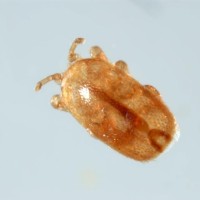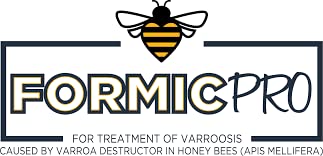
The name Tropilaelaps might still be unfamiliar to many UK beekeepers – but that won’t last long. According to leading entomologist and bee inspector Dr. Maggie Gill, these parasitic mites could become the most severe challenge to beekeeping since Varroa destructor.
Discovered spreading across Eastern Europe, Tropilaelaps is now within striking distance of the UK, with confirmed reports in Georgia, Russia, and unconfirmed cases in Crimea and Belarus. With ongoing queen bee imports from nearby regions, the risk is real and growing.
This post explains what Tropilaelaps is, how it spreads, and – critically – how UK beekeepers can monitor and prepare.
What Is Tropilaelaps?
Tropilaelaps is a genus of parasitic mites that originally infested giant Asian honeybees. But in the early 20th century, it jumped species to Apis mellifera (our western honeybee). Of the four known Tropilaelaps species, Tropilaelaps mercedesae and Tropilaelaps clareae pose the greatest threat to European beekeeping.
Like Varroa, Tropilaelaps reproduce inside sealed brood cells, feeding on developing bee larvae. But Tropilaelaps has a much shorter life cycle, faster reproduction rate, and more damaging feeding behavior. Infestations can kill entire colonies in as little as three months.
Why Tropilaelaps Is Worse Than Varroa
| Feature | Varroa | Tropilaelaps |
|---|---|---|
| Size | Larger | 1/3 size of Varroa |
| Speed | Slow | Fast, highly mobile |
| Feeding | One site | Multiple open wounds |
| Reproduction cycle | 12–14 days | 6–7 days |
| Phoretic phase | 5–7 days | Often <24 hours |
| Winter survival | Limited | Possibly viable via imports |
Because they spend less time on adult bees, standard Varroa treatments are mostly ineffective. Chemical treatments like oxalic or thymol-based products don’t reach Tropilaelaps, which stay hidden inside the brood.
How Could Tropilaelaps Reach the UK?
Tropilaelaps mites are spreading fast, mainly through migratory beekeeping and international trade.
⚠️ Queen and package bee imports pose a real risk.
Maggie’s research found that Tropilaelaps can survive for up to 5 days on newly emerged bees and up to 8 days on dead bees or brood, meaning:
- Mites can travel in bee shipments, even those without live brood
- Mites may hitchhike on shipping containers, wild swarms, and illegal imports of honeycomb
Despite the UK’s recent ban on queen imports from Ukraine, imports continue from Romania, Greece, and other nations bordering known infestation zones.
🛑 Used beekeeping equipment also poses a threat – currently, there’s no requirement to sterilize imported equipment.
What Can UK Beekeepers Do Now?
1. Monitor Proactively
Early detection is critical. Maggie and her team have developed field-tested detection methods:
- Brood Uncapping: Most effective but time-intensive. Use wax depilation strips for speed.
- Icing Sugar Roll: Encourages bees to dislodge mites; effective with minimal harm.
- Sticky Floor Inserts: Use vegetable oil or petroleum jelly to trap falling mites.
- Comb Bump: Not recommended due to brood damage risk.
👉 Watch Phira Science videos on Tropilaelaps monitoring (free resources and guides).
2. Rethink Imports
If you’re importing queens or bees:
- Prefer locally raised queens
- Avoid untracked imports, especially from Eastern or Southeastern Europe
- Support local breeding programs and bee improvement groups
⚠️ Beware of indirect imports via Ireland into the UK, which are harder to monitor.
3. Get Familiar With Control Options
Biotechnical methods like shook swarms, queen caging, and brood breaks work but are labour-intensive.
Chemical control is limited. Only formic acid (e.g., Formic Pro) penetrates brood cells.
- Maggie’s trials in Georgia showed 99% kill rates using Formic Pro under ideal temperature and humidity.
- But weather conditions impact efficacy; in poor conditions, queen loss and colony stress may occur.
More work is needed to refine dosage and delivery, but formic acid remains the only effective chemical option.
Is It Too Late?
Not yet – but the clock is ticking.
If Tropilaelaps becomes established, losses could rival or exceed the early days of Varroa. In countries like Thailand and Georgia, untreated colonies die within one season.
Tropilaelaps doesn’t just threaten hives – it endangers pollination, crop production, and the entire beekeeping economy.
Final Thoughts: Prevention Starts Now
Tropilaelaps isn’t a hypothetical threat – it’s real, it’s close, and it spreads fast.
✅ Monitor your hives regularly
✅ Avoid risky imports
✅ Educate your fellow beekeepers
Dr. Maggie Gill and the Phira Science team are leading the charge. Their research has already influenced UK policy on queen imports. But they rely on grassroots support from beekeepers like you.
🌍 Visit https://www.phira-science.org/research/tropilaelaps for updates, free videos, and detection guides.
🛒 Buy the new book: Tropilaelapsosis – Biology, Detection and Control by Gill et al.

